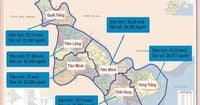In a significant administrative overhaul, the Dong Nai provincial government has laid out a plan to reorganize its administrative units, reducing the number of wards and communes from 159 to 55. This decision follows a recent directive from the provincial People's Committee, which emphasized the importance of gathering public opinions and conducting local council meetings to discuss the proposed changes.
Currently, Dong Nai province is home to 159 administrative units at the ward and commune level. The proposed rearrangement aims to streamline these units significantly. For instance, Bien Hoa City, which presently comprises 25 wards and communes (including 24 wards and 1 commune), will be restructured into just 9 administrative units. Notably, some familiar names such as Bien Hoa ward and Tran Bien are expected to be retained, giving continuity to the local identity.
One of the more intriguing aspects of the plan includes the expansion of Trang Dai ward to encompass Thien Tan commune from Vinh Cuu district. Similarly, Tan Phong ward will merge with three other communes from Vinh Cuu district—Tan Binh, Binh Loi, and Thanh Phu—bringing the total population of this new administrative unit to over 100,000 residents.
Four wards located along the Dong Nai River, which borders Binh Duong province and Ho Chi Minh City, will also be merged into a new ward under Bien Hoa City. This restructuring reflects a broader trend in the region, where municipalities are aiming to optimize administrative efficiency.
In addition to Bien Hoa, other cities and districts in Dong Nai are following suit. Long Khanh City, which currently has 13 administrative units, plans to reduce this number to 5 while retaining familiar names such as Long Khanh, Binh Loc, Hang Gon, Bao Vinh, and Xuan Lap. Similarly, Long Thanh district will cut down its administrative units from 14 to 5, keeping names that resonate with local heritage.
Meanwhile, Nhon Trach district, with its 12 communes and towns, is proposing to maintain just 3 administrative units named Nhon Trach, Dai Phuoc, and Phuoc An. Trảng Bom district is also set to streamline from 17 to 5 units, retaining names like Trảng Bom, An Viễn, Bình Minh, Bàu Hàm, and Hưng Thịnh. Thống Nhất district's administrative units will be reduced from 10 to 3, including Thống Nhất, Dầu Giây, and Gia Kiệm.
In Cẩm Mỹ district, the proposal will leave 5 administrative units: Cẩm Mỹ, Sông Ray, Xuân Quế, Xuân Đông, and Thừa Đức. Xuân Lộc district will reduce its number of units from 15 to 6, keeping names such as Xuân Lộc, Xuân Định, Xuân Phú, Xuân Thành, Xuân Bắc, and Gia Ray. Dinh Quan district will cut its units from 14 to 5, including La Ngà, Định Quán, Thanh Sơn, Phú Vinh, and Phú Hòa. Vĩnh Cửu district is also proposing to reduce its administrative units from 10 to 4, namely Tân Triều, Phú Lý, Trị An, and Tân An. Finally, Tân Phú district will streamline from 16 to 5 units, with expected names like Tà Lài, Nam Cát Tiên, Tân Phú, Phú Lâm, and Đắc Lua.
In another region, Hai Phong City and Hai Duong province are also making adjustments to their administrative naming conventions. After receiving public feedback, local authorities have shifted from a numbering system for naming communes to a more culturally and historically relevant naming approach. In Hai Duong, the provincial party committee has directed localities to propose names based on long-standing local names, notable figures, and cultural traditions. This shift aims to reflect the unique identity of each locality.
Previously, some localities had considered naming new communes using a combination of the old administrative unit names and serial numbers, such as “Nam Sach 1” or “Kinh Mon 2.” However, this approach faced significant public opposition for failing to capture the local historical and cultural essence. In Hai Phong, districts like Vinh Bao and Tien Lang have similarly adjusted their naming plans to incorporate historical and cultural elements instead of relying solely on numerical designations.
For example, in Vinh Bao district, new names for the communes post-rearrangement include Vinh Am, Vinh Hai, Nguyen Binh Khiem, Vinh Bao, Vinh Hoa, Vinh Thinh, and Vinh Thuan. Tien Lang district has proposed names such as Quyet Thang, Tien Lang, Tan Minh, Tien Minh, Chan Hung, and Hung Thang for its new administrative units. Additionally, old village names with historical significance will be used for naming hamlets and residential areas after the rearrangement.
In Hai An district, plans have been developed to reduce the number of wards from 8 to 2, with proposed names reflecting historical values. Many residents have voiced their preference for names that resonate with the area's history instead of numerical labels.
Meanwhile, in Ho Chi Minh City, the 10th People's Council recently approved a resolution to rearrange administrative units at the commune level, reducing the number from 273 to 102 new units. This decision was made during the 22nd session of the council on April 18, 2025. The restructuring includes significant merges, such as combining 34 wards in Thu Duc City into just 12 new wards, while District 1 will see its 10 wards reduced to 4.
For instance, wards like Tan Dinh and part of Da Kao will merge to form a new Tan Dinh ward, while Ben Thanh and Pham Ngu Lao wards will combine with parts of other wards to create a new Ben Thanh ward. This trend continues across various districts, with each district proposing specific merges and new names that reflect the local culture and identity.
The HCMC People's Council has tasked the City People's Committee with finalizing the documentation for this administrative overhaul and submitting it for approval. The resolution takes effect immediately upon its passage, marking a significant step in the ongoing efforts to optimize administrative efficiency and preserve local identities.
As these administrative changes unfold across various regions, the emphasis on public input and cultural significance highlights a growing recognition of the importance of local identity in governance.






